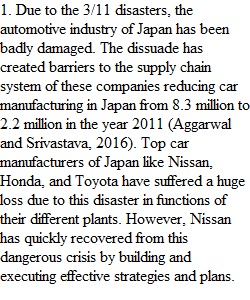


Q Prompt: Case: Nissan: Recovering Supply Chain Operations by Shikha Aggarwal and Manoj Kumar Srivastava (available thru the Harvard Coursebook that you have to purchase) Citation: Aggarwal, S. and Srivastava, M.K. (2016). Nissan: Recovering Supply Chain Operations. Ontario, Canada: Ivey Publishing. 16 Pages. Product Number 9B20M114. Nissan's resilience strategy had been considered an exemplary response to the triple disaster in Japan in March 2011. The Japanese automobile industry made their respective recovery efforts to resume production and delivery of vehicles after suffering damage from an earthquake, tsunami, and a nuclear crisis, but it took months before they could reach pre-disaster levels of operations. Nissan's resilience practices and supply chain disruption management were acknowledged as superior to those of their peers and were appreciated by experts and analysts. Nonetheless, it took Nissan more than a month to resume production, and each day of lost production cost Nissan $25 million. Learning Objective: The case can be used in graduate-level business courses in supply-chain management, operations management, and strategic management. The case provides an opportunity for students to • understand the concept of supply-chain resilience; • identify potential disruptions in a global supply-chain network; • analyze the best design-disruption fit in a supply chain; • understand operations strategies to manage supply-chain disruptions; • formulate improvement strategies for building robustness; • and understand reconciliation of supply-chain capabilities with vulnerabilities. Assignment description: Each student will answer the following four questions. Students should limit their responses to information they ‘gleen’ from the readings as well as any relevant current events (don’t spend a lot of time finding current events – 99% of the ‘details’ / information will be in the readings. If you do additional research – which is always encouraged (in every course) - seek out research sources through the Steely librarians (online) as well as consider performing extensive research online with regard to the questions. In addition, a number of universities have information sources which may be helpful (and free). Students are not expected to pay for information. If you are having difficulty seeking information, contact the instructor for assistance. Once again, all the relevant information is available in the Harvard Coursebook collection that you purchased. You should not need to seek outside (of the Harvard Coursebook) information. Students should plan on writing at least 1000 words (250 per question; approx. 15 lines of text) This assignment is due no later than 23:59 EST on Sunday of Week 3 and must be submitted via Canvas. Questions to answer: (use questions #’s or headings to separate your answers) 1. Critically analyze Nissan's business continuity plan (BCP) to recover its supply chain operations. 2. What are the operational strategies for managing supply chain disruptions? Evaluate Nissan on each of these. 3. What resilience strategies did Nissan use? 4. In your opinion, had Nissan developed the perfect recovery strategy or is there still room for improvement for future crisis? Instructions: 1. All posts should be done by 23:59 EST Sunday of Week 3. 2. References and 'proper' academic style citing of the references are required. Points will be lost by a lack of references or the improper citation of references. Points will not be gained by proper use of references or citations. They are expected to be utilized. The references most likely will be from one of the articles in the Harvard 1. Remember: Interactions are in writing – business style or essay style are acceptable. 2. A majority of your text in bullets is not acceptable. Grading Rubric Your assignment will be graded according to the grading rubric. Rubric Assignment Rubric Assignment Rubric Criteria Ratings Pts This criterion is linked to a Learning OutcomeCommand of Learning Materials 55 to >49.0 pts Excellent • Shows thoughtful, analytical interpretation of module materials and/or case content. • Demonstrates significant original thought that goes beyond the obvious. • Explicitly references module or case materials relevant to analysis. 49 to >42.0 pts Acceptable • Relies primarily on summarizing module materials and/or case content. • Demonstrates some original thought. • Does not explicitly reference module or case materials relevant to analysis. 42 to >0 pts Not So Good • Little or no connection to relevant module learning materials or case content. • Demonstrates no original thinking. 55 pts This criterion is linked to a Learning OutcomeResponse to Assigned Task 55 to >49.0 pts Excellent • Addresses all aspects of the assignment prompt or case question(s) fully, in appropriate depth and detail. 49 to >42.0 pts Acceptable • Addresses most aspects of the assignment prompt or case question(s) but misses a small part. OR • Addresses all aspects of the assignment prompt or case question(s) but lacks appropriate depth or detail. 42 to >0 pts Not So Good • Non-responsive to significant aspects of the assignment prompt or case question(s). OR • Content not relevant to the assignment prompt or case question(s). 55 pts This criterion is linked to a Learning OutcomeWriting Quality 40 to >36.0 pts Excellent • Clear, concise, and compelling. • Well organized thoughts. • Appropriate paragraph format. • No grammatical or mechanical errors. • Follows all assignment format instructions (e.g., document length). 36 to >30.0 pts Acceptable • Very minor difficulty in understanding content. • Somewhat disorganized thoughts. • Lack of appropriate paragraphing. • Minor grammatical or mechanical errors. • Some assignment format instructions not followed. 30 to >0 pts Not So Good • Significant difficulty in understanding content. • Extremely disorganized thoughts. • No paragraphing. • Multiple grammatical or mechanical errors. • No assignment format instructions followed. 40 pts Total Points: 150 PreviousNext
View Related Questions